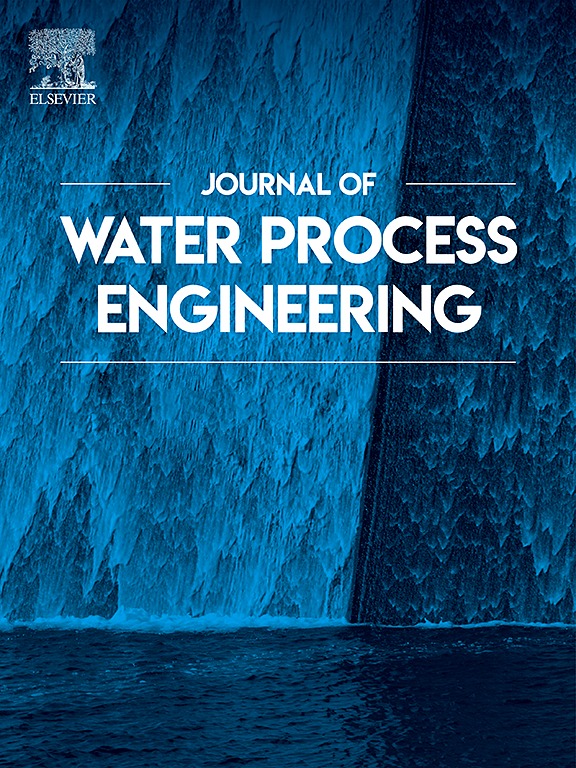噻苯并-15-冠醚-5 衍生物对钯的高效和选择性回收
IF 6.7
2区 工程技术
Q1 ENGINEERING, CHEMICAL
引用次数: 0
摘要
本研究设计并合成了含不同硫原子数的冠醚衍生物单噻吩-15-冠-5醚(MTB15C5)和二噻吩-15-冠-5醚(DTB15C5),用于高效、选择性地回收钯。用单晶XRD分析了MTB15C5和DTB15C5与Pd(II)形成的配合物[(MTB15C5)2·PdCl2]和[(DTB15C5)·PdCl2]的配位机理。在[(MTB15C5)2·PdCl2]和[(DTB15C5)·PdCl2]结构中分别观察到由SPd配位键形成的反式和顺式方形结构的S2PdCl2片段。多个分子内[C-H···Cl-Pd]氢键维持了配合物的构象。在液液萃取(LLE)回收Pd(II)的原理验证实验中,MTB15C5和DTB15C5在接触时间15 min和10 min内分别可提取98%的Pd(II)。MTB15C5和DTB15C5在含多离子溶液中对Pd(II)的萃取效率分别为98.9%和99.7%,远高于竞争离子(一般低于8%),表明两种硫冠醚对Pd(II)具有良好的选择性萃取能力。Job’s plot和高分辨率质谱分析证实,在LLE过程中,钯的萃取是通过MTB15C5和DTB15C5与Pd(II)分别以2:1和1:1的化学计量量进行配位,在有机相中形成[(MTB15C5)2·PdCl2]和[(DTB15C5)·PdCl2]配合物实现的。本文章由计算机程序翻译,如有差异,请以英文原文为准。

Efficient and selective recovery of palladium by Thiabenzo-15-crown-5 ether derivatives
In the present study, two crown ether derivatives containing different numbers of sulfur atoms, monothiabenzo-15-crown-5 ether (MTB15C5) and dithiabenzo-15-crown-5 ether (DTB15C5), were designed and synthesized for efficient and selective recovery of palladium. The complexes formed of MTB15C5 and DTB15C5 with Pd(II), [(MTB15C5)2·PdCl2] and [(DTB15C5)·PdCl2], were analyzed by single crystal XRD to clarify the coordination mechanisms. The trans and cis square configured S2PdCl2 fragments formed through S![]() Pd coordination bonds were observed in the structures of [(MTB15C5)2·PdCl2] and [(DTB15C5)·PdCl2], respectively. Multiple intramolecular [C-H···Cl-Pd] hydrogen bonds were demonstrated to maintain the conformation of the complexes. In the proof-of-principle experiments for Pd(II) recovery through liquid-liquid extraction (LLE), >98 % of Pd(II) can be extracted within a contact time of 15 and 10 min by MTB15C5 and DTB15C5, respectively. The extraction efficiencies of Pd(II) in multi-ions containing solutions by MTB15C5 and DTB15C5 were 98.9 % and 99.7 %, respectively, which were much higher than the competitive ions (generally below 8 %), showing the excellent selective extractability of the two thiacrown ethers toward Pd(II). Job's plot and high-resolution mass spectrometry analysis confirmed that the extraction of palladium is achieved through the coordination of MTB15C5 and DTB15C5 with Pd(II) in the stoichiometries of 2:1 and 1:1, respectively, forming the complexes of [(MTB15C5)2·PdCl2] and [(DTB15C5)·PdCl2] in the organic phase during the LLE process.
Pd coordination bonds were observed in the structures of [(MTB15C5)2·PdCl2] and [(DTB15C5)·PdCl2], respectively. Multiple intramolecular [C-H···Cl-Pd] hydrogen bonds were demonstrated to maintain the conformation of the complexes. In the proof-of-principle experiments for Pd(II) recovery through liquid-liquid extraction (LLE), >98 % of Pd(II) can be extracted within a contact time of 15 and 10 min by MTB15C5 and DTB15C5, respectively. The extraction efficiencies of Pd(II) in multi-ions containing solutions by MTB15C5 and DTB15C5 were 98.9 % and 99.7 %, respectively, which were much higher than the competitive ions (generally below 8 %), showing the excellent selective extractability of the two thiacrown ethers toward Pd(II). Job's plot and high-resolution mass spectrometry analysis confirmed that the extraction of palladium is achieved through the coordination of MTB15C5 and DTB15C5 with Pd(II) in the stoichiometries of 2:1 and 1:1, respectively, forming the complexes of [(MTB15C5)2·PdCl2] and [(DTB15C5)·PdCl2] in the organic phase during the LLE process.
求助全文
通过发布文献求助,成功后即可免费获取论文全文。
去求助
来源期刊

Journal of water process engineering
Biochemistry, Genetics and Molecular Biology-Biotechnology
CiteScore
10.70
自引率
8.60%
发文量
846
审稿时长
24 days
期刊介绍:
The Journal of Water Process Engineering aims to publish refereed, high-quality research papers with significant novelty and impact in all areas of the engineering of water and wastewater processing . Papers on advanced and novel treatment processes and technologies are particularly welcome. The Journal considers papers in areas such as nanotechnology and biotechnology applications in water, novel oxidation and separation processes, membrane processes (except those for desalination) , catalytic processes for the removal of water contaminants, sustainable processes, water reuse and recycling, water use and wastewater minimization, integrated/hybrid technology, process modeling of water treatment and novel treatment processes. Submissions on the subject of adsorbents, including standard measurements of adsorption kinetics and equilibrium will only be considered if there is a genuine case for novelty and contribution, for example highly novel, sustainable adsorbents and their use: papers on activated carbon-type materials derived from natural matter, or surfactant-modified clays and related minerals, would not fulfil this criterion. The Journal particularly welcomes contributions involving environmentally, economically and socially sustainable technology for water treatment, including those which are energy-efficient, with minimal or no chemical consumption, and capable of water recycling and reuse that minimizes the direct disposal of wastewater to the aquatic environment. Papers that describe novel ideas for solving issues related to water quality and availability are also welcome, as are those that show the transfer of techniques from other disciplines. The Journal will consider papers dealing with processes for various water matrices including drinking water (except desalination), domestic, urban and industrial wastewaters, in addition to their residues. It is expected that the journal will be of particular relevance to chemical and process engineers working in the field. The Journal welcomes Full Text papers, Short Communications, State-of-the-Art Reviews and Letters to Editors and Case Studies
 求助内容:
求助内容: 应助结果提醒方式:
应助结果提醒方式:


